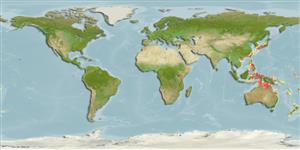Classification / Names
Common names | Synonyms | Catalog of Fishes (gen., sp.) | ITIS | CoL | WoRMS | Cloffa
Actinopterygii (ray-finned fishes) >
Ophidiiformes (Cusk eels) >
Carapidae (Pearlfishes) > Carapinae
Etymology: Echiodon: Greek, echieys, eos = a little viper + Greek, odous = teeth (Ref. 45335).
Environment / Climate / Range
Ecology
Marine; demersal; depth range 0 - 79 m (Ref. 5275). Subtropical, preferred ?
Northwest Pacific: Japan. Western Central Pacific: Philippines (Ref. 10698). Southwest Pacific: Australia (Ref. 75154).
Size / Weight / Age
Maturity: Lm ? range ? - ? cm
Max length : 17.2 cm TL male/unsexed; (Ref. 10698)
Short description
Morphology | Morphometrics
Diagnosis: Pectoral fin rays 15 - 16; total nasal lamellae 22 (Ref. 10698).
Found on the continental shelf and slope (Ref. 75154).
Life cycle and mating behavior
Maturity | Reproduction | Spawning | Eggs | Fecundity | Larvae
Williams, J.T. and Y. Machida, 1992. Echiodon anchipterus: a valid western Pacific species of the pearlfish family Carapidae with comments on Eurypleuron. Jap. J. Ichthyol. 38(4):367-373. (Ref. 10698)
IUCN Red List Status (Ref. 115185)
CITES (Ref. 94142)
Not Evaluated
Threat to humans
Harmless
Human uses
More information
Common namesSynonymsMetabolismPredatorsEcotoxicologyReproductionMaturitySpawningFecundityEggsEgg development
Age/SizeGrowthLength-weightLength-lengthLength-frequenciesMorphometricsMorphologyLarvaeLarval dynamicsRecruitmentAbundance
ReferencesAquacultureAquaculture profileStrainsGeneticsAllele frequenciesHeritabilityDiseasesProcessingMass conversion
Tools
Special reports
Download XML
Internet sources
Estimates of some properties based on models
Phylogenetic diversity index (Ref.
82805): PD
50 = 0.5001 [Uniqueness, from 0.5 = low to 2.0 = high].
Bayesian length-weight: a=0.00102 (0.00046 - 0.00225), b=3.06 (2.88 - 3.24), in cm Total Length, based on all LWR estimates for this body shape (Ref.
93245).
Trophic Level (Ref.
69278): 3.6 ±0.5 se; Based on size and trophs of closest relatives
Resilience (Ref.
69278): .
Vulnerability (Ref.
59153): Low vulnerability (10 of 100) .
